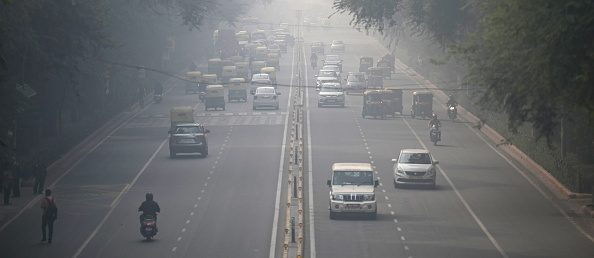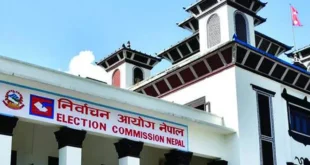Dr. Seema Javed
The national capital of Delhi is among the most polluted cities in the world, with its citizens exposed to unsafe levels of toxic ultrafine air particulate matter (PM) and other pollutants throughout the year. While probable solutions to the crisis are discussed in plenty, gaps in policy implementation hamper progress. A recent study by Climate Trends and Earth Root Foundation found that 94.8% of Municipal
Corporation of Delhi (MCD) officials were aware of air pollution, but national policies and health impacts of air pollution were lesser-known among the implementing agency’s field workers.
Corporation of Delhi (MCD) officials were aware of air pollution, but national policies and health impacts of air pollution were lesser-known among the implementing agency’s field workers.
Between October and December 2021, researchers conducted in-depth interviews with various levels of staff from MCD to understand their knowledge, awareness and attitude toward air pollution. Most respondents (94.8%) were aware of the term ‘air pollution,’ but National Clean Air Program (NCAP) and City Action Plans (CAPs) aren’t common terminologies among staffers. Only about 72.4% of engineers and 53% of the inspectors were aware of the national policies concerning air pollution.

In its first phase, the study covered two zones- ‘West and Nazafgarh’ in the SDMC region and the NDMC zone, and included engineers working under the Department of Environment Management Services (DEMS), MCD inspectors, and ground staff.
According to the respondents, the key sources of air pollution were vehicular pollution (99%), Construction and Road Dust (94%) and stubble burning (91.5%). However, when questioned about more technical details, the officials from MCDs seemed unaware.
Research shows that long-term exposure to PM2.5 pollution is associated with illness and early death from various diseases, including ischemic heart disease, lung cancer, COPD, lower respiratory infections (such as pneumonia), stroke, type 2 diabetes and adverse birth
outcomes. However, the study shows that most respondents associated only respiratory problems, dizziness, and eye irritation as health impacts of air pollution. Only about 20% of respondents believed that air pollution could impact the prevalence of diseases such as
cancer, heart disease and skin problems.
outcomes. However, the study shows that most respondents associated only respiratory problems, dizziness, and eye irritation as health impacts of air pollution. Only about 20% of respondents believed that air pollution could impact the prevalence of diseases such as
cancer, heart disease and skin problems.
“Air pollution is one of the biggest health concerns in urban areas. In India, many cities are highly polluted due to fossil fuel-polluting sources such as smokestacks, industries and factories. It also harms our health. Our study shows that while urban local bodies are aware of the problems, their staf isn’t very aware of its ef ects on human health and the immediate action they can take to avoid excessive exposure to air pollution. It is because of this gap that implementation of policies is hampered, and the impacts continue,” said Dr. Vivek Panwar (Secretary), Secretary, Earth Root Foundation.
The sustained interaction with the MCD officials brought forth the common challenges implementing agencies face on the ground. While workers are acutely aware of the obstacles, they find themselves ill-equipped to bring meaningful change. The study found that staff
members at ULBs have inadequate knowledge and understanding of their roles in pollution mitigation. As a result, they have a casual approach towards their work.
members at ULBs have inadequate knowledge and understanding of their roles in pollution mitigation. As a result, they have a casual approach towards their work.
Aarti Khosla,Director, Climate Trends said, “Air pollution is now a problem for the capital city all around the year, and the local government needs to prioritise the issue within its systems. Civic issues like waste management, broken roads, and sewer lines are the kind of issues MCD is normally held accountable. Air pollution has to be a part of the broken issues which must be fixed. It is as much a civic issue which MCD should address as any other infrastructure issue. At the upcoming MCD elections, there should be a recognition that better coordination and improved accountability mechanisms should be there to ensure our policies are implemented in their truest sense.”
The study identifies hurdles such as the multiplicity of agencies, inadequate knowledge and understanding of their roles in pollution mitigation, lack of supervision and quality control and lack of coordination among citizens and multi-disciplinary working groups involving key stakeholders, including experts, NGOs, and various community groups like Resident Welfare Associations etc. Prof S N Tripathi, Steering Committee member, NCAP, MoEFCC, Coordinator, National Knowledge Network; Civil Engineering dept, IIT Kanpur said, “The Institutes of Repute (IOR) that are in partnership with the urban local bodies provide scientific support in air pollution control measures that are required under NCAP.
Additionally, the ministries and their allied agencies also conduct several capacity-building workshops for the staff of ULBs. However, not all ULBs have dedicated staff for air pollution measures, which is often not a priority task for many of them. There is a need to bridge this gap and hire skilled air quality professionals to help strengthen the implementation of the robust national level policies.”
The study recommends that it is important to understand the benefits and costs associated with interventions to improve air quality, as most air pollution reduction measures have clear health and social benefits that far outweigh implementation costs.
Amongst Prominent Delhi Citizens’, Bhavreen Malhotra Kandhari, Environmentalist, Co-Founder, Warrior Moms “Government/s are usually busy addressing the citizens for their role to solve air pollution while ignoring the fact that their own officials who have to implement the laws are not sensitised on a critical issue like air pollution which is also a public health issue . There is an urgent need for a mass sensitisation program to help enforcement of such laws needed for the officials and staff . Instead of massive advertisement campaigns, stress should be on regular sensitisation workshops on air pollution for officers and also legislators and designing simple pocket toolkits exhibiting various laws can help local authorities to adopt a robust and effective local approach that will complement a national strategy from the
government.”
government.”
Atul Goyal, President, United Residents Joint Action (URJA) “The capacity of municipal officials and staff to perform is highly compromised with lack of tools and equipment, standard operative procedures, human resources, budget gaps between action and grants, knowledge sharing and inter-departmental communications and citizen participation mechanisms. The guiding force to perform with actionable
solutions are missing as most of the staff and officials are over the age of 50 years and this is a big deterrent for them to perform.”
solutions are missing as most of the staff and officials are over the age of 50 years and this is a big deterrent for them to perform.”
 Jubilee Post News & Views
Jubilee Post News & Views





